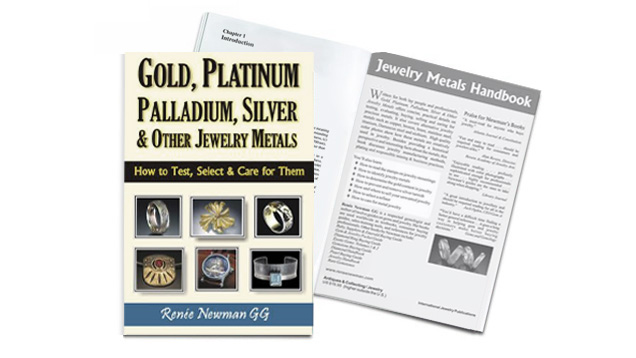Book Review: Gold, Platinum, Palladium, Silver & Other Jewelry Metals: How to Test, Select & Care for Them

Though not characterized this way, there is almost a cradle-to-grave approach at work here. You can learn sources of information about jewelry, old and new, how to verify the nature and quality of the materials, and tips on acquiring jewelry, caring for it, and reselling unwanted pieces. There’s even a bit about do-it-yourself metal testing (you can’t keep a good jewelry appraiser down!) and a simple way to remove tarnish from silver. It’s simply jammed full of a wide range of useful information that’s well illustrated and easily readable. What’s not to love?
Who’s the target reader for this book? That could be just about anyone, from the layperson who wants to know more about jewelry to an industry professional seeking a broader perspective. The book is so wide-ranging that it would be hard to imagine anyone not getting their money’s worth. Broad range can imply a shallow depth, but that is definitely not the case here. One of the first things I do with a book is to peek at its index, bibliography, acknowledgments, and table of contents. This gives me an idea how well researched a book is, and the kind of scope I might expect. Newman’s list of contributors is impressive. The works cited come from a broad range of sources, and the topics span from ancient to cutting-edge.
The book starts with some general background on metals and is arranged in eight chapters that discuss specific metals and families of metals that share common characteristics. The chapters have a nice blending of scientific, historical, practical, and commercial knowledge. In each chapter there are charts to draw distinctions between alloys, clear images of hallmarking stamps one will encounter, and wonderful photographs. The photos offer compelling examples of each metal, showing off its color and beauty and how a variety of makers use it in their designs, along with close-ups that hone in on various details.
Roughly half of the book is devoted to its survey of metals, and the balance is spent covering manufacturing methods, the differences and consequences of real versus fake jewelry (some interesting legal points here), valuation, care, determining fineness or karat value, and plating and coatings. Last but not least, I’m giving the author a Good Citizenship merit badge for including a chapter titled “Responsible Mining and Manufacturing.” Newman rightly points out the more enlightened path that many are taking in this regard. She lists best practices and cites numerous organizations concerned with environmental impact, origin and chain-of-custody issues, health and safety, social responsibility, and ethics. Brava!
You will be enriched by having read this book, and will value and use the information contained within it.
Douglas Hall
Gemological Institute of America
Carlsbad, California



